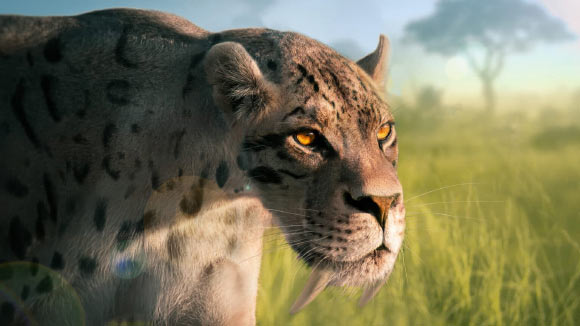The American lion (Panthera atrox) may have roared, while the saber-toothed cat Smilodon fatalis may have produced vocalizations similar to living purring cats but at a lower frequency.
Modern cats belong to one of two groups: either the pantherine ‘big cats,’ including the roaring lions, tigers and jaguars; or Felinae ‘little cats,’ which include purring cats like lynxes, cougars, ocelots and domestic cats.
“Evolutionarily speaking, sabertooths split off the cat family tree before these other modern groups did,” North Carolina State University’s Professor Adam Hartstone-Rose.
“This means that lions are more closely related to housecats than either are to sabertooths.”
“That’s important because the debate over the kind of vocalization a sabertooth tiger would have made relies upon analyzing the anatomy of a handful of tiny bones located in the throat.”
“And the size, shape and number of those bones differ between modern roaring and purring cats.”
Although vocalization is driven by the larynx and soft tissue in the throat, not bones, anatomists noticed that the bones responsible for anchoring those tissues in place — the hyoid bones — differed in size and number between roaring and purring cats.
“While humans have only one hyoid bone, purring cats have nine bones linked together in a chain and roaring cats have seven,” said Ashley Deutsch, a Ph.D. student at North Carolina State University.
“The missing bones are located toward the top of the hyoid structure near where it connects to the skull.”
“Because saber-toothed tigers only have seven bones in their hyoid structure, the argument has been that of course they roared,” Professor Hartstone-Rose said.
“But when we looked at the anatomy of modern cats, we realized that there isn’t really hard evidence to support this idea, since the bones themselves aren’t responsible for the vocalization.”
“That relationship between the number of bones and the sound produced hasn’t ever really been proven.”
The researchers compared the hyoid structures of four species of roaring cats (lions, tigers, leopards and jaguars) and five species of purring cats (cougars, cheetahs, caracals, servals and ocelots) to 105 hyoid bones from Smilodon fatalis and one from Panthera atrox.
“You can argue that since the sabertooths only have seven bones they roared, but that’s not the whole story,” Professor Hartstone-Rose said.
“The anatomy is weird. They’re missing extra bones that purring cats have, but the shape and size of the hyoid bones are distinct. Some of them are shaped more like those of purring cats, but much bigger.”
According to the researchers, if the missing bones (called epihyoid bones) were key to different vocalizations, the bones most closely connected to them should look different between the two groups.
However, those bones looked very similar in shape whether they came from purring or roaring cats.
In fact, the researchers saw more shape variation in the bones closer to the vocal apparatus; i.e., the thyrohyoid and basihyoid bones.
The uniformity of the upper bones between the two groups suggests that if the hyoid structure plays a role in vocalization, the lower bones are more important than the upper ones.
So having these key hyoid bones shaped like those of purring cats could indicate that they purred rather than roared.
“Panthera atrox and Smilodon fatalis had larger and more robust hyoids than living cats, potentially reflecting the ability to produce lower frequency vocalizations as well as more substantial muscles associated with swallowing and respiration.”
“Based on the shape of the hyoid elements, Panthera atrox resembled roaring cats, while Smilodon fatalis was quite variable and, contrary to suggestions from previous research, more similar overall to purring felids.”
“Thus Panthera atrox may have roared and Smilodon fatalis may have produced vocalizations similar to extant purring cats but at a lower frequency.”
“Due to the confounding of vocalization repertoire and phylogenetic history in living Felidae, we cannot distinguish between morphological signals related to vocalization behavior and those related to shared evolutionary history unrelated to vocalization.”
The findings were published in the Journal of Morphology.
_____
Ashley R. Deutsch et al. The roar of Rancho La Brea? Comparative anatomy of modern and fossil felid hyoid bones. Journal of Morphology, published online August 20, 2023; doi: 10.1002/jmor.21627








